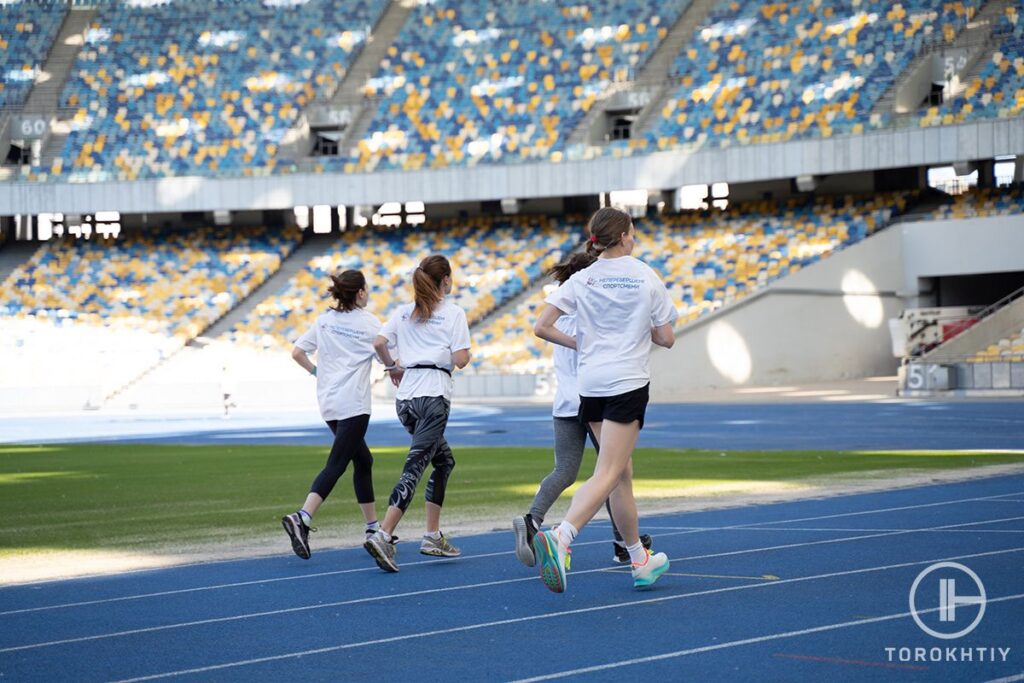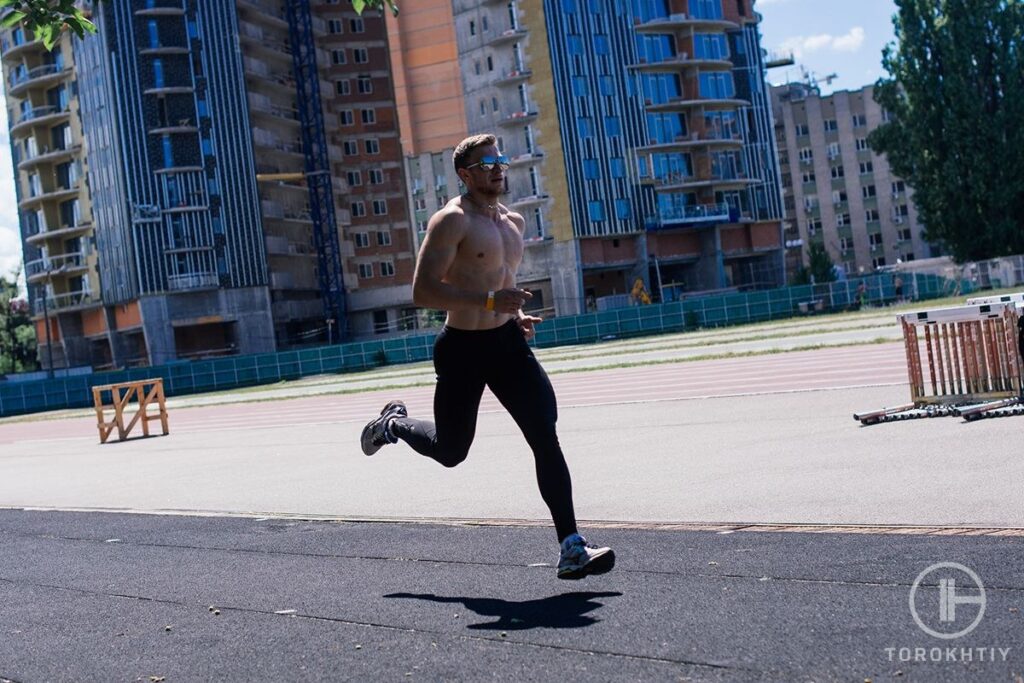3 Day a Week Running Plan For Marathon: 16 Weeks of Workouts
Author:
Reviewed by:
(Head of Sport Science, 20 years of Oly Lifting experience, PhD Sport Science)
Unlock your full potential by engaging with our experts and community! Have questions about your fitness journey or looking for expert advice on weightlifting techniques? Don’t hesitate — leave a comment below and Oleksandr Zagrebelnyi will provide a personalized answer and insights to help you reach your goals.
Torokhtiy is reader-supported. Some links are affiliate links, and we may earn a commission at no extra cost to you. See our disclosure page for details.
A history of running injuries or not having enough time for training might discourage you from signing up for a marathon. But you can’t let these obstacles hinder your goals. We have a solution for you: a 3 day a week running plan for a marathon! This creative approach will lead you to your goal: the finish line.
It’s time to prepare for your next marathon. Let’s dive into proven 3 days a week marathon training and make the most of the next 16 weeks!
What is a 3 day a week running plan for marathons? – It combines three different types of runs—long runs, tempo runs, and speed runs—along with cross-training sessions to go through the finish line in just 16 weeks.

3 Days a Week Running Plan
Back in the 1980s, it was a new and original approach that raised many questions until these days.
Bill Pierce, a marathoner and chair of the Health Sciences Department at Furman University, and his friend Scott Murr, a veteran in the sport of triathlon, decided to compete in a few triathlons.
Their training program led to the creation of the Furman Institute of Running and Scientific Training (FIRST) marathon program and the idea that it’s possible to run less and still get amazing results.
They decided to cut their running from six times a week to four. And the results were surprising: Their time in local road races didn’t slow down. So, they decided to take another step and reduce their running training to three times per week.

Pierce, who has run 31 marathons, said, “Lo and behold, our 10K, half-marathon, and marathon times didn’t suffer at all. The more we discussed this—and we discussed it a lot—the more we became convinced that a three-day program, with some cross-training, was enough to maintain our running fitness.”
Research conducted by Pierce shows the effectiveness of the program and how he let his peers finish the marathon. Since then, many people have followed this 3-day-a-week marathon training plan to not only achieve their running goals but also complete their marathons. You don’t have to go through intense training sessions or run for whole weeks.
Is Three Days of Running Enough?
Running three days per week can be enough to complete a marathon. However, it won’t be possible if you only train for running; as cross-training workouts are also required.
So, to achieve success with a 3-day-a-week marathon training program, it is crucial to maintain consistency and diligence in completing every workout.
For Whom Is 3 Day Marathon Training Plan Suitable?
Everyone can follow a 3 days a week marathon training plan, but some people prefer it more than others. For instance, this plan is usually ideal for runners who are injury prone and for people who don’t have enough time or motivation to run every day.
Another significant group of people who enjoy this training schedule are people who like variety in their workout routine and don’t want to focus exclusively on running.
What’s important to note is that if your goal is better performance, a marathon training plan 3 days a week isn’t the best fit. According to exercise physiologists and coaches, focusing on specific training is essential to make progress and adapt. This means doing the type of exercise you plan on competing in. Or in other words: if you want to become a better runner, you need to run more.

Depending on your specific goal and fitness level, you can follow this plan to achieve shorter distances as well as marathons and half-marathons. Beginners without previous marathon experience should first set a shorter running goal, like 10K.
After completing it, you should set another one with more distance this time. However, for more experienced people who already run longer distances, it’s more than possible to finish a half-marathon or a marathon after this training plan.
Marathon Training 3 Days a Week: Pros And Cons
There is no training plan that will fit everyone like a glove. So, naturally, we can discuss the advantages and disadvantages of this approach. And it is up to you to weigh them and decide whether the training schedule can suit your fitness level and goals, or not.
✅ Advantages
- Time efficiency: Many people have busy lives with work, family, and other commitments. A 3-day-a-week plan can be more manageable for those who can’t dedicate the time required for a more frequent training regimen.
- Reduced risk of overtraining: Running long distances frequently can increase the risk of overuse injuries, especially for beginners or individuals prone to injuries. A 3-day-a-week plan may reduce the overall mileage and provide more recovery time, potentially lowering the risk of injury.
- Cross-training emphasis: With fewer running days, there’s room to add cross-training activities like cycling, swimming, or strength training. Cross-training can improve overall fitness, reduce injury risk, and add variety to your routine.
- Goal achievement: If your main objective is to finish a marathon rather than aim for a particular time, this plan could be a great fit. This is especially true for individuals who have some baseline fitness or running experience.
❌ Disadvantages
- Limited mileage: With only three days of running per week, the total weekly mileage is typically lower compared to more traditional marathon training plans. This reduced distance can potentially affect your overall endurance, making it challenging to adequately prepare for the marathon.
- Less adaptation time: A more frequent training schedule allows your body to adapt gradually to the stresses of running and reduces the risk of injury. With fewer training days, your body may not have sufficient time to adapt to the demands of long-distance running.
- Limited performance improvement: If your goal is not just to complete the marathon but also to improve your performance and achieve a specific time goal, a 3-day plan may not be optimal to achieve significant performance gains.
4 Types of Training During 3 Day Running Program
From the very beginning of this program, it consists of different types of training and runs, including long runs, tempo runs, speed runs, and cross-training.
1. Long Runs (LR)
In 3 day a week marathon training, long runs (LR) are conducted once a week. The distance will gradually increase but won’t reach the entire marathon distance. Also, it’s not necessary to run the full distance before race day. In fact, it can be counterproductive for most marathon runners, aside from elite athletes, because it is overly stressful and exhausting.

During this plan, you will run long runs of 20 to 22 miles. These runs are necessary for psychologically preparing yourself for the marathon. But, your pace must be slower than your marathon race pace. These 20-mile runs will be a valuable opportunity for you to spend a significant amount of time on your feet, just like during the actual marathon.
2. Tempo Runs (TR)
Tempo runs (TR) focus on running at a steady but comfortably hard pace. The goal of these runs is to improve your lactate threshold, which is the point at which your body starts to accumulate lactic acid faster than it can be cleared away. You should perform this type of run at a pace that’s around 80-90% of your maximum effort, or about the pace you could sustain for an hour-long race.
3. Speed Runs (SR)
Speed runs (SR) involve shorter bursts of very high-intensity running, often at (or near) your maximum effort. These workouts aim to increase your top-end speed, stride efficiency, and neuromuscular coordination. Your speed runs should consist of short intervals, such as 200/400/800 meters, with rest periods in between.
4. Cross-Training (CT)
Cross-training workouts improve your aerobic fitness and allow you to rest your feet after running. You must include this training because it will strengthen your heart, lungs, and overall cardiorespiratory system. Cross-training (CT) results in efficiency and endurance during a marathon.

You can select any form of cardio exercise for your cross-training workouts. However, cycling, deep water running, rowing, elliptical, and stair climbing are some good options. During these workouts, aim for Zone 2 efforts, which means keeping your heart rate at 60-70% of its maximum.
16 Weeks Training Plan For a Marathon
So, every week you will have three running training days, two rest days, and two cross-training.
| Week | Monday | Tuesday | Wednesday | Thursday | Friday | Saturday | Sunday |
|---|---|---|---|---|---|---|---|
| Week 1 | 30 minutes cross-training | 2 miles warm up 8x400m at 5K pace with 200m jog 1 mile cool down | Rest day | 2 miles warm up 3 miles tempo run 1 mile cool down | 60 minutes of cross-training | Rest day | Long run of 10 miles |
| Week 2 | 30 minutes cross-training | 6×800 at 10K pace with 200m jog 1 mile cool down | Rest day | 2 miles warm up 5 miles tempo run 1 mile cool down | 60 minutes of cross-training | Rest day | Long run of 12 miles |
| Week 3 | 40 minutes cross-training | 6x1000m at 5K pace with 200m jog 1 mile cool down | Rest day | 6 miles tempo run 1 mile cool down | 65 minutes of cross-training | Rest day | Long run of 14 miles |
| Week 4 | 40 minutes cross-training | 4x1600m at 10K pace with 200m jog 1 mile cool down | Rest day | 2×4 mile tempo run with 90 seconds in between 1 mile cool down | 65 minutes of cross-training | Rest day | Long run of 11 miles |
| Week 5 | 40 minutes cross-training | 12x400m at 5K pace with 200m jog 1 mile cool down | Rest day | 2 miles warm up 8 miles tempo run 1 mile cool down | 70 minutes of cross-training | Rest day | Long run of 15 miles |
| Week 6 | 45 minutes cross-training | 2 miles warm up 8×800 at 5K pace with 200m jog 1 mile cool down | Rest day | 2 miles warm up 2×5 miles tempo run with 90 seconds in between 1 mile cool down | 70 minutes of cross-training | Rest day | Long run of 16 miles |
| Week 7 | 45 minutes cross-training | 2 miles warm up 1×1600 at 10K pace with 200m jog 2x1200m at 5K pace 2×800 at 5K pace 2x400m at 5K pace 1 mile cool down | Rest day | 2 miles warm up 8 miles tempo run 1 mile cool down | 75 minutes of cross-training | Rest day | Long run of 17 miles |
| Week 8 | 45 minutes cross-training | 2 miles warm up 10x800m at 5K pace with 200m jog 1 mile cool down | Rest day | 2 miles warm up 10 miles tempo run 1 mile cool down | 75 minutes of cross-training | Rest day | Long run of 15 miles |
| Week 9 | 45 minutes cross-training | 2 miles warm up 12x400m at 5K pace with 200m jog 1 mile cool down | Rest day | 2 miles warm up 6 miles tempo run 1 mile cool down | 80 minutes of cross-training | Rest day | Long run of 20 miles |
| Week 10 | 50 minutes cross-training | 2 miles warm up 4 x 1600m at 10k pace with 200m jog 1 mile cool down | Rest day | 2 miles warm up 8 miles tempo run 1 mile cool down | 80 minutes of cross-training | Rest day | Long run of 17 miles |
| Week 11 | 50 minutes cross-training | 2 miles warm up 2 x 3200m at 10k pace with 200m jog 1 mile cool down | Rest day | 2 miles warm up 6 mile tempo run 1 mile cool down | 60 minutes of cross-training | Rest day | Long run of 20 miles |
| Week 12 | 55 minutes cross-training | 2 miles warm up 12 x 400m at 5k pace with 200m jog 1 mile cool down | Rest day | 2 miles warm up 6 mile tempo run 1 mile cool down | 90 minutes of cross-training | Rest day | Long run of 16 miles |
| Week 13 | 55 minutes cross-training | 2 miles warm up 6 x 1000m at 10k pace with 200m jog 1 mile cool down | Rest day | 2 miles warm up 5 mile tempo run 1 mile cool down | 75 minutes of cross-training | Rest day | Long run of 20-22 miles |
| Week 14 | 60 minutes cross-training | 2 miles warm up 2 x 400m at 5k pace with 200m jog 2 x 800m at 5k pace with 200m jog 2 x 1200m at 5k pace with 200m jog 1 x 1600m at 10k pace 1 mile cool down | Rest day | 2 miles warm up 6 mile tempo run 1 mile cool down | 80 minutes of cross-training | Rest day | Long run of 16 miles |
| Week 15 | 60 minutes cross-training | 2 miles warm up 10 x 400m at 5k pace with 200m jog 1 mile cool down | Rest day | 2 miles warm up 5 miles tempo run 1 mile cool down | 60 minutes of cross-training | Rest day | Long run of 10 miles |
| Week 16 | 45 minutes cross-training | Run 5-8 miles | Rest day | Run 30 minutes or cross-train 30 minutes | Rest day | 10-20 minutes easy jog | Marathon! |
4 Tips to Prepare For Marathon
Although these 16 weeks ahead might be challenging, you can follow these tips to make it a bit easier. Some important ones are:
1. Organize Your Time Wisely
This marathon training plan requires time and dedication. You must be very organized during these 16 weeks of training to ensure consistency not only in training but also in regular life. Consider planning and preparing your meals one week ahead to maximize your time and efficiency.
2. Focus on Quality
Since you have fewer running days than usual, make each workout count. Stay mentally engaged by monitoring your form, breathing, and overall effort.

3. Watch Your Nutrition And Stay Hydrated
Proper nutrition and hydration are essential for recovery and performance. Ensure you’re fueling your body with nutritious foods, staying hydrated, and consuming enough carbohydrates to support your marathon training.
4. Wear Proper Gear
Good equipment is crucial for any runner, especially when preparing for a marathon. The right gear can enhance your comfort, reduce the risk of injury, and contribute to a more enjoyable training experience.
Hoka Bondi 8
- Material: Breathable and supportive mesh upper
- Sole Material: Full-length EVA midsole for maximum cushioning
- Outsole (tread feature): Durable rubber outsole with a unique lug pattern
- Drop: 4mm
- Season: Suitable for all seasons
- Special Features: Exceptional cushioning and comfort
- Size: Available in various sizes
- Type: Maximum cushioning running shoe
If you want excellent running or walking shoes or just footwear you’ll be comfortable in, you can’t go wrong with the Hoka Bondi 8.
It’s been upgraded and now they have lighter, softer materials and a new extended heel design. The heel design gives a super soft, balanced feeling from th emoment your heel hits the ground to when you push off with your toes.
As far as the weight goes, it’s around 10.80 ounces, and the heel drop is 4 mm. They’re not too heavy and the lower drop is a good balance between cushioning and feeling connected to the ground.
The Bondi 8 is focused on cushioning and keeps things simple. There’s a good amount of support without any extra stuff that you don’t really need and that would only jack up the price. Take the rear crash pad, for example – it makes for a soft, smooth ride, which is perfect if you like to run outdoors.

The upper part is made of engineered mesh, which is breathable and keeps your feet cool and dry. The tongue and collar have memory foam and mold to your foot shape. All of these features make the fit snug but flexible, which is exactly what you would want.
The Bondi 8 is eco-friendly because it uses recyclable materials in parts like the mesh and the sockliner. Plus, the shoes are completely vegan, which (if that’s important to you) is nice!
Frequently Asked Questions About 3-Day a Week Running Plan For Marathon
Is it possible to train for a marathon by running only 3 days a week?
Yes, it is possible to train for a marathon by running 3 days a week, but it can be more challenging compared to a traditional training plan with higher weekly mileage. If you’re an experienced marathon runner with a history of injuries, this plan might work perfectly for you! But if you’re a beginner, a marathon is probably more than you can chew by running only three times a week. In that case, consider running a half-marathon or 10K first.
Is it better to run every day or 3 times a week?
The decision between running every day or running three times a week depends on several factors, including your goals, fitness level, recovery ability, and overall lifestyle. There is no one-size-fits-all answer, as both approaches have their pros and cons. Typically, everyday running is better suited for experienced runners who have developed a strong aerobic base, have a solid understanding of their bodies, and can manage the increased demand on their muscles and joints.
Is running 3 times a week enough?
As we already mentioned, if your goal is to finish a marathon or participate in a triathlon, three running sessions per week are enough. But if your goal is to improve your performance in a marathon or beat your personal best, this plan might not be enough.
Wrapping Up Everything About 3-Day a Week Running Plan For Marathon
In a nutshell, you can cross the finish line in 16 weeks if you follow a 3 day a week running plan for a marathon. It will require dedication, and a lot of sweat, but you definitely can do it! This plan is an excellent combo of different runs and cross-training. So, if you decide to go on this journey, it will be an exciting but challenging path.
If you haven’t tried the three days a week training plan, why not give it a shot? Share your thoughts with us in the comments below—your input is invaluable.
Join the conversation with other runners and improve your running skills! Engaging in discussions with like-minded individuals is a proven way to elevate your running game.
References:
- Pierce committed to students’ best interests // Scholarly Exchange: https://scholarexchange.furman.edu/cgi/viewcontent.cgi?article=2233&context=furman-magazine
- Main Page // Furman University Scholar Exchange (FUSE): https://www.furman.edu/first/
- Three radical // Furman University : https://www.furman.edu/first/wp-content/uploads/sites/168/2020/01/Three-Radical.pdf
- Summary of Bill Pierce & Scott Murr’s Runner’s World Run Less Run Faster // Scribd: https://www.scribd.com/book/599813754/Summary-of-Bill-Pierce-Scott-Murr-s-Runner-s-World-Run-Less-Run-Faster
- An Internal Focus of Attention Is Not Always as Bad as Its Reputation: How Specific Aspects of Internally Focused Attention Do Not Hinder Running Efficiency // Human Kinetics: https://journals.humankinetics.com/abstract/journals/jsep/36/3/article-p233.xml
- 9 Best Running Shoes For Heel Strikers In 2023 // PacePassion: https://pacepassion.com/gear-reviews/best-running-shoes-for-heel-strikers/
- Photos by Torokhtiy Media Team.
Why Trust Us?
With over 20 years in Olympic weightlifting, strength training, nutrition coaching, and general fitness our team does its best to provide the audience with ultimate support and meet the needs and requirements of advanced athletes and professional lifters, as well as people who strive to open new opportunities and develop their physical capabilities with us.
By trusting the recommendations of our certified experts in coaching, nutrition, and sports training programming, as well as scientific consultants, and physiotherapists, we provide you with thorough, well-considered, and scientifically proven content. All the information given in the articles concerning workout programming, separate exercises, and athletic performance, in general, is based on verified data.
The product testing process is described in more detail here.
Oleksandr is a running coach and member of the Nike Run Club coaching team for 8 years. A participant in national and international competitions at distances from one kilometer to the ultra trail. Owner of mountain trail running camps. Nowadays Oleksandr is responsible for creating running training programs for athletes of various levels, coaching personally offline and online, conducts trail running camps in the mountains, participates in competitions.
Reviewed by: Sergii Putsov
Head of Sport Science, PhD
Best Results: Snatch – 165 kg,
C&J – 200 kg
Sergii Putsov, Ph.D., is a former professional weightlifter and National team member, achieving multiple medals in the 94 kg weight category at national competitions. With a Master’s degree in “Olympic & Professional Sport Training” and a Sport Science Ph.D. from the International Olympic Academy, Greece, Sergii now leads as the Head of Sport Science. He specializes in designing training programs, writing insightful blog articles, providing live commentary at international weightlifting events, and conducting educational seminars worldwide alongside Olympic weightlifting expert Oleksiy Torokhtiy.





Still have questions after reading our article? Unlock your full potential by engaging with our experts and community! Don’t hesitate — leave a comment below and Oleksandr Zagrebelnyi will provide a personalized answer and insights to help you reach your goals.